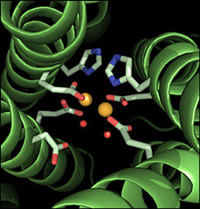Study shows deepwater oil plume in Gulf degraded by microbes
In the aftermath of the explosion of BP's Deepwater Horizon drilling rig in the Gulf of Mexico, a dispersed oil plume was formed at a depth between 3,600 and 4,000 feet and extending some 10 miles out from the wellhead. An intensive study by scientists with the Lawrence Berkeley National Laboratory (Berkeley Lab) found that microbial activity, spearheaded by a new and unclassified species, degrades oil much faster than anticipated. This degradation appears to take place without a significant level of oxygen depletion.
"Our findings show that the influx of oil profoundly altered the microbial community by significantly stimulating deep-sea psychrophilic (cold temperature) gamma-proteobacteria that are closely related to known petroleum-degrading microbes," says Terry Hazen, a microbial ecologist with Berkeley Lab's Earth Sciences Division and principal investigator with the Energy Biosciences Institute, who led this study. "This enrichment of psychrophilic petroleum degraders with their rapid oil biodegradation rates appears to be one of the major mechanisms behind the rapid decline of the deepwater dispersed oil plume that has been observed."
The uncontrolled oil blowout in the Gulf of Mexico from BP's deepwater well was the deepest and one of the largest oil leaks in history. The extreme depths in the water column and the magnitude of this event posed a great many questions. In addition, to prevent large amounts of the highly flammable Gulf light crude from reaching the surface, BP deployed an unprecedented quantity of the commercial oil dispersant COREXIT 9500 at the wellhead, creating a plume of micron-sized petroleum particles. Although the environmental effects of COREXIT have been studied in surface water applications for more than a decade, its potential impact and effectiveness in the deep waters of the Gulf marine ecosystem were unknown.
Analysis by Hazen and his colleagues of microbial genes in the dispersed oil plume revealed a variety of hydrocarbon-degraders, some of which were strongly correlated with the concentration changes of various oil contaminants. Analysis of changes in the oil composition as the plume extended from the wellhead pointed to faster than expected biodegradation rates with the half-life of alkanes ranging from 1.2 to 6.1 days.
"Our findings, which provide the first data ever on microbial activity from a deepwater dispersed oil plume, suggest that a great potential for intrinsic bioremediation of oil plumes exists in the deep-sea," Hazen says. "These findings also show that psychrophilic oil-degrading microbial populations and their associated microbial communities play a significant role in controlling the ultimate fates and consequences of deep-sea oil plumes in the Gulf of Mexico."
Hazen and his colleagues attribute the faster than expected rates of oil biodegradation at the 5 degrees Celsius temperature in part to the nature of Gulf light crude, which contains a large volatile component that is more biodegradable. The use of the COREXIT dispersant may have also accelerated biodegradation because of the small size of the oil particles and the low overall concentrations of oil in the plume. In addition, frequent episodic oil leaks from natural seeps in the Gulf seabed may have led to adaptations over long periods of time by the deep-sea microbial community that speed up hydrocarbon degradation rates.
One of the concerns raised about microbial degradation of the oil in a deepwater plume is that the microbes would also be consuming large portions of oxygen in the plume, creating so-called "dead-zones" in the water column where life cannot be sustained. In their study, the Berkeley Lab researchers found that oxygen saturation outside the plume was 67-percent while within the plume it was 59-percent.
"The low concentrations of iron in seawater may have prevented oxygen concentrations dropping more precipitously from biodegradation demand on the petroleum, since many hydrocarbon-degrading enzymes have iron as a component," Hazen says. "There's not enough iron to form more of these enzymes, which would degrade the carbon faster but also consume more oxygen."
Original publication: Terry Hazen, Eric Dubinsky, Todd DeSantis, Gary Andersen, Yvette Piceno, Navjeet Singh, Janet Jansson, Alexander Probst, Sharon Borglin, Julian Fortney, William Stringfellow, Markus Bill, Mark Conrad, Lauren Tom, Krystle Chavarria, Thana Alusi, Regina Lamendella, Dominique Joyner, Chelsea Spier, Jacob Baelum, Manfred Auer, Marcin Zemla, Romy Chakraborty, Eric Sonnenthal, Patrik D'haeseleer, Hoi-Ying Holman, Shariff Osman, Zhenmei Lu, Joy Van Nostrand, Ye Deng, Jizhong Zhou and Olivia Mason; "Deep-sea oil plume enriches Indigenous oil-degrading bacteria."; Science 2010.
























































